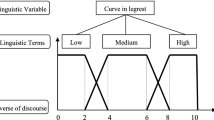Abstract
This paper presents a graph and matrix representation scheme for the functional design of mechanical products, which provides a good basis to generate an explicit and comprehensive functional model used for functional reasoning. Three key features of the scheme are (1) The representation of the causal way behaviors are interconnected; (2) The representation of two types of functional relations: decomposed into and supported by; and (3) Support for diverse functional reasoning paths: three alternative B-FES/e paths are currently available. The scheme can guide functional design of mechanical products through functional reasoning steps including functional supportive synthesis, causal behavioral reasoning and functional decomposition. The developed functional model and its representation applied in a knowledge-based design environment can speed up the functional design process by automating functional reasoning steps. The proposed approach has been evaluated with a functional design example of a terminal cutoff unit in an automatic assembly system for manufacturing electronic connectors.
Similar content being viewed by others
References
Pahl G, Beitz W (1996) Engineering design – a systematic approach, 2nd edn. Springer, London
Otto K, Wood K (2001) Product design: techniques in reverse engineering and new product development. Prentice-Hall, Upper Saddle River, NJ
Tor SB, Britton GA, Chandrashekar M, Ng KW (1998) Functional design. In: Usher J, Roy U, Parsaei H (eds) Integrated product and process development: methods, tools and technologies. Wiley, New York, pp 29–58
Bracewell RH, Sharpe JEE (1996) Functional descriptions used in computer support for qualitative scheme generation – ‘schemebuilder’. Artif Intell Eng Des Anal Manuf 10(4):333–345
Umeda Y, Ishii M, Yoshioka M, et al. (1996) Supporting conceptual design based on the function-behavior-state modeler. Artif Intell Eng Des Anal Manuf 10(4):275–288
Deng Y-M, Tor SB, Britton GA (2000) Abstracting and exploring functional design information for conceptual product design. Eng Comput 16:36–52
Tor SB, Britton GA, Zhang WY, Deng Y-M (2002) Guiding functional design through rule-based causal behavioral reasoning. Int J Prod Res 40:667–682
Giarratano J, Riley G (1998) Expert systems: principles and programming, 3rd edn. PWS, Boston
Chakrabarti A, Blessing L (1996) Special issue: representing functionality in design. Artif Intell Eng Des Anal Manuf 10(4):251–253
de Kleer J, Brown JS (1984) A qualitative physics based on confluences. Artif Intell 24:7–83
Paynter HM (1961) Analysis and design of engineering systems. MIT Press, Cambridge, MA
Rosenberg RC, Karnopp DC (1983) Introduction to physical system dynamics. McGraw-Hill, New York
Lind M (1994) Modeling goals and functions of complex industrial plants. Applied artificial intelligence. 8(2):259–283
Szykman S, Racz J, Sriram R (1999) The representation of function in computer-based design. Proceedings of the ASME design theory and methodology conference, DETC99/DTM-8742, Las Vegas, NV
Chittaro L, Ranon R (1999) Diagnosis of multiple faults with flow-based functional models: the functional diagnosis with efforts and flows approach. Reliab Eng Syst Safety 64:137–150
Umeda Y, Takeda H, Tomiyama T, et al. (1990) Function, behavior and structure. In: Gero JS (ed) Applications of artificial intelligence in engineering V. Springer-Verlag, Berlin, pp 177–193
Qian L, Gero JS (1996) Function-behavior-structure paths and their role in analogy-based design. Artif Intell Eng Des Anal Manuf 10(4):289–312
Goel A (1991) Model revision: a theory of incremental model learning, Proceedings of the 8th International Conference on Machine Learning, Chicago, IL. Morgan Kaufmann, Los Altos, CA, pp 605–609
Prabhakar S, Goel A (1998) Functional modeling for enabling adaptive design of devices for new environments. Artif Intell Eng 12:417–444
Forbus K (1984) Qualitative process theory. Artif Intell 24(3):85–168
Deng Y-M, Britton GA, Tor SB (1998) A design perspective of mechanical function and its object-oriented representation scheme. Eng Comput 14:309–320
Zhang WY, Tor SB, Britton GA (2002) An approach of two-level modeling to acquire functional design knowledge in mechanical engineering systems. Int J Adv Manuf Technol 19(6):454–460
Valero A, Torres C (1988) Algebraic thermodynamic analysis of energy systems. Approaches to the Design Optimization of Thermal Systems, ASME AES-7, pp 13–23
Li CL, Tan ST, Chan KW (1996) A qualitative and heuristic approach to the conceptual design of mechanisms. Eng Appl Artif Intell 9(1):17–31
Author information
Authors and Affiliations
Corresponding author
Rights and permissions
About this article
Cite this article
Zhang, W., Tor, S. & Britton, G. A graph and matrix representation scheme for functional design of mechanical products. Int J Adv Manuf Technol 25, 221–232 (2005). https://doi.org/10.1007/s00170-003-1827-3
Received:
Accepted:
Published:
Issue Date:
DOI: https://doi.org/10.1007/s00170-003-1827-3




